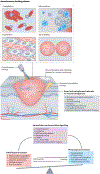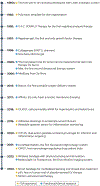Wound management materials and technologies from bench to bedside and beyond
- PMID: 40535534
- PMCID: PMC12176411
- DOI: 10.1038/s41578-024-00693-y
Wound management materials and technologies from bench to bedside and beyond
Abstract
Chronic wounds represent a major global health problem, causing staggering economic and social burdens. The pursuit of effective wound healing strategies demands a multidisciplinary approach, and advances in material sciences and bioengineering have paved the way for the development of novel wound healing biomaterials and technologies. In this Review, we provide an overview of the history and challenges of wound management and highlight the current state-of-the-art in wound healing biomaterials alongside the emerging technologies poised to transform the landscape of chronic wound treatment and monitoring. Moreover, we discuss the clinical and commercial considerations associated with wound healing strategies, including the regulatory pathways and key steps in the translational process. Furthermore, we highlight existing translational gaps, and offer a nuanced understanding of the challenges that persist in translating innovative concepts into mainstream clinical practices. Continued innovations and interdisciplinary collaboration will pave the way for better wound care outcomes and potentially dramatically improved quality of life for a steadily increasing and aging population.
Conflict of interest statement
Competing interests The authors declare no competing interests.
Figures




Similar articles
-
Assessing the comparative effects of interventions in COPD: a tutorial on network meta-analysis for clinicians.Respir Res. 2024 Dec 21;25(1):438. doi: 10.1186/s12931-024-03056-x. Respir Res. 2024. PMID: 39709425 Free PMC article. Review.
-
Effectiveness of Telemedicine on Wound-Related and Patient-Reported Outcomes in Patients With Chronic Wounds: Systematic Review and Meta-Analysis.JMIR Mhealth Uhealth. 2025 Jun 10;13:e58553. doi: 10.2196/58553. JMIR Mhealth Uhealth. 2025. PMID: 40493508 Free PMC article.
-
Introducing the dataset for measuring centrality for sustainability-A case study of Pecinci municipality, Serbia.Data Brief. 2025 May 27;61:111714. doi: 10.1016/j.dib.2025.111714. eCollection 2025 Aug. Data Brief. 2025. PMID: 40534919 Free PMC article.
-
Defining disease severity in atopic dermatitis and psoriasis for the application to biomarker research: an interdisciplinary perspective.Br J Dermatol. 2024 Jun 20;191(1):14-23. doi: 10.1093/bjd/ljae080. Br J Dermatol. 2024. PMID: 38419411 Free PMC article. Review.
-
Biomaterials and Nanotherapeutics for Enhancing Skin Wound Healing.Front Bioeng Biotechnol. 2016 Oct 31;4:82. doi: 10.3389/fbioe.2016.00082. eCollection 2016. Front Bioeng Biotechnol. 2016. PMID: 27843895 Free PMC article. Review.
Cited by
-
Natural multi-active nanoparticles integrated biological hydrogel microcarriers for wound healing.J Nanobiotechnology. 2025 Aug 22;23(1):582. doi: 10.1186/s12951-025-03666-7. J Nanobiotechnology. 2025. PMID: 40846937
-
Advanced cell-adaptable hydrogels for bioprinting.Bioact Mater. 2025 Aug 6;53:831-854. doi: 10.1016/j.bioactmat.2025.07.044. eCollection 2025 Nov. Bioact Mater. 2025. PMID: 40822307 Free PMC article. Review.
-
Lighting the Path to Precision Healthcare: Advances and Applications of Wearable Photonic Sensors.Adv Mater. 2025 Jan 26:e2419161. doi: 10.1002/adma.202419161. Online ahead of print. Adv Mater. 2025. PMID: 39865847 Review.
-
Role of chemistry in nature-inspired skin adhesives.Chem Sci. 2025 May 30;16(24):10665-10690. doi: 10.1039/d5sc01777g. eCollection 2025 Jun 18. Chem Sci. 2025. PMID: 40474951 Free PMC article. Review.
-
D-Tryptophan Promotes Skin Wound Healing via Extracellular Matrix Remodeling in Normal and Diabetic Models.Int J Mol Sci. 2025 Jul 24;26(15):7158. doi: 10.3390/ijms26157158. Int J Mol Sci. 2025. PMID: 40806291 Free PMC article.
References
-
- Gurtner GC, Werner S, Barrandon Y & Longaker MT Wound repair and regeneration. Nature 453, 314–321 (2008). - PubMed
-
- Armstrong DG & Gurtner GC A histologically hostile environment made more hospitable? Nature reviews. Endocrinology 14, 511–512 (2018). - PubMed
-
- Nussbaum SR et al. An Economic Evaluation of the Impact, Cost, and Medicare Policy Implications of Chronic Nonhealing Wounds. Value in Health 21, 27–32 (2018). - PubMed
Grants and funding
LinkOut - more resources
Full Text Sources
